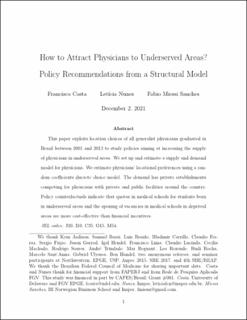How to Attract Physicians to Underserved Areas? Policy Recommendations from a Structural Model
| dc.contributor.author | Sanches, Fabio Miessi | |
| dc.contributor.author | Costa, Francisco | |
| dc.contributor.author | Nunes, Leticia | |
| dc.date.accessioned | 2023-08-22T11:31:05Z | |
| dc.date.available | 2023-08-22T11:31:05Z | |
| dc.date.created | 2022-01-04T17:21:32Z | |
| dc.date.issued | 2021 | |
| dc.identifier.issn | 0034-6535 | |
| dc.identifier.uri | https://hdl.handle.net/11250/3085240 | |
| dc.description.abstract | This paper exploits location choices of all generalist physicians graduated in Brazil between 2001 and 2013 to study policies aiming at increasing the supply of physicians in underserved areas. We set up and estimate a supply and demand model for physicians. We estimate physicians' locational preferences using a random coefficients discrete choice model. The demand has private establishments competing for physicians with private and public facilities around the country. Policy counterfactuals indicate that quotas in medical schools for students born in underserved areas and the opening of vacancies in medical schools in deprived areas are more cost-effective than financial incentives. | en_US |
| dc.language.iso | eng | en_US |
| dc.publisher | MIT | en_US |
| dc.title | How to Attract Physicians to Underserved Areas? Policy Recommendations from a Structural Model | en_US |
| dc.type | Journal article | en_US |
| dc.type | Peer reviewed | en_US |
| dc.description.version | submittedVersion | en_US |
| dc.source.journal | Review of Economics and Statistics | en_US |
| dc.identifier.doi | 10.1162/rest_a_01155 | |
| dc.identifier.cristin | 1974660 | |
| cristin.ispublished | false | |
| cristin.fulltext | preprint | |
| cristin.qualitycode | 2 |
